It’s incredible to think Formula 1’s V6 hybrid turbo regulations are now in their sixth year, with one major update to those rules along the way, and in that time no one has managed to un-seat Mercedes as champions.
The 2019 F1 season brings the second big rewrite to these rules, largely concerning aerodynamics. Will the Mercedes chassis and powertrain be able maintain their dominance?Unveiled at a private shakedown at Silverstone, Mercedes revealed their tenth car since returning to F1, the W10. Subject to huge anticipation by fans and rivals alike, the surprise is perhaps the car isn’t that different to its predecessors, at a time with its rivals are making bigger changes to their car in bid to beat the new regulations and Mercedes. Will it be enough?
Its hard to pinpoint one reason for Mercedes dominance since the new power unit regulations came in for 2014. The team have many aces: its engine power, qualifying modes, refined aerodynamics and great handling. You would have to look not at the car, but the team, to understand it’s the engineering at the factory that is their trump card.
That’s not to say they don’t have their limitations: tyre management and race strategy have been weak points for Mercedes, particularly through the early season when they seem to struggle to adapt as quickly as their rivals.
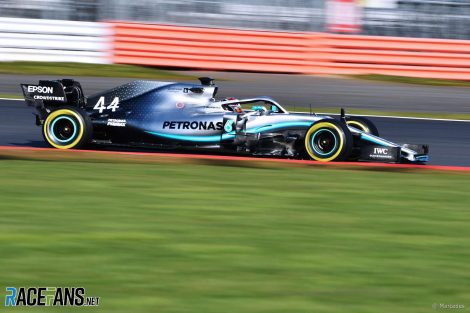
If you looked at the W10 in another colour scheme and analysed it, you’d say it wasn’t a winning design when compared to any other car. But Mercedes have made their engineering approach and resulting counter-design decisions work so successfully, you start to wonder why another team hasn’t yet tried Mercedes long wheelbase/low rake design.
Out first look at the new car shows these approaches are still in place. The W10 exhibits no obvious change in wheelbase, rake, nor radically different approach to its aero. But there remain some areas where its clear they have thought long and hard about new solutions.
Additionally, Mercedes often bring one major update to the car quite early in the year, typically for the start of the ‘European season’, so some aspect of the aero will change a lot, while the car’s basic architecture is unlikely to alter through the season.
Advert | Become a RaceFans supporter and
Front wing: Inwash or Outwash?
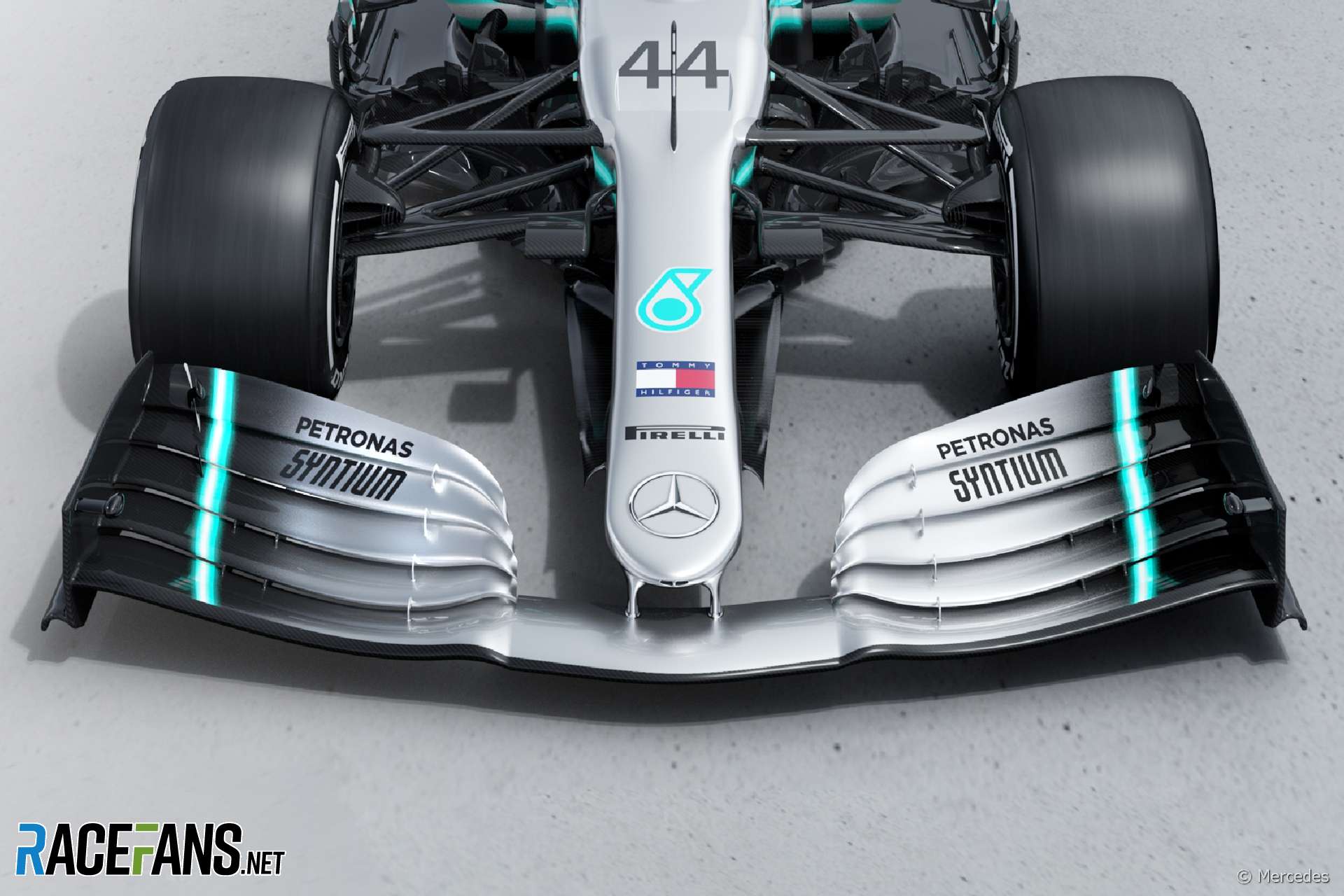
The front wings for 2019 we’ve seen so far have been very much cookie-cutter responses to the new rules. These ‘Version 1.0’ wings haven’t exhibited any trick solutions, although the Mercedes has one eye-catching feature on its front wing endplate.
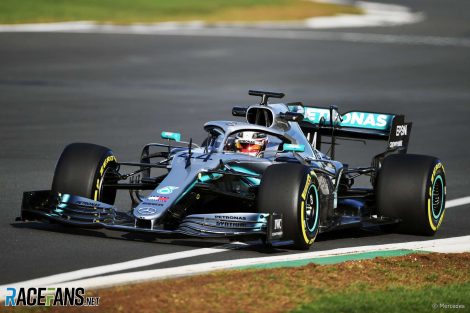
Mercedes’ launch spec wing still sports an endplate which outwashes as much as the rules allow, but the rear top corner leans in slightly. This has led some observers to term it an inwash design. This isn’t quite the case, the endplate is still some way from the inner face of the front wheel and unable to create the extreme of inwash design seen pre-2009. It seems counter intuitive to lean the endplate back and aimed directly towards the tyre, but what Mercedes appear to be doing is playing the airflow spilling off the top of the endplate.
Much of the airflow outside a typical endplate will outwash out around the front tyre. This will help to quell the vortices the tyre generates when its cylindrical shape hits the oncoming air. F1 teams commonly create and direct vortices off bodywork that contra-rotate and control other unwanted vortices created downstream.
With an outwash endplate, the pressure building up on the outer face of the endplate spills over the top and forms a vortex trailing from the inner face of the endplate. This places the path of the vortex very close to the tyre, most likely missing the tyre’s own vortex, and thus will have little effect in managing the tyre wake. Leaning the top edge of the endplate inwards means that pressure now builds up inside the endplate, thus the vortex spills over and spins the opposite direction and further from the tyre.
It’s likely that Mercedes have done this to direct the endplate vortex more accurately, to negate the tyre vortex, thus reducing the effect of the tyres dirty wake hitting the rear bodywork. Other teams are likely to create stepped edges to the top of the endplate to create just this sort of effect, but have yet to reveal these solutions to us.
Go ad-free for just £1 per month
>> Find out more and sign up
Front suspension
Since the change to wider cars and wider tyres in 2017, Mercedes have used the wider front wheel to play with the front wishbone position and still retain reasonable suspension geometry. This high wishbone position moves the two suspension members higher up and thus clears space for the front wing wake to expand into without obstructing it.
By mounting the front wishbones higher relative to the chassis, this pushes the upper mount for the front upright outside of the wheel. Rules allow a camber plate to extend out from the upright to connect to the wishbones, thus we see the Mercedes front wheel pivot high up and external to the wheel/brake duct. Toro Rosso came to the same conclusion in 2017, but dropped the design from their current car; Mercedes have continued with it on the W10.
Sidepods
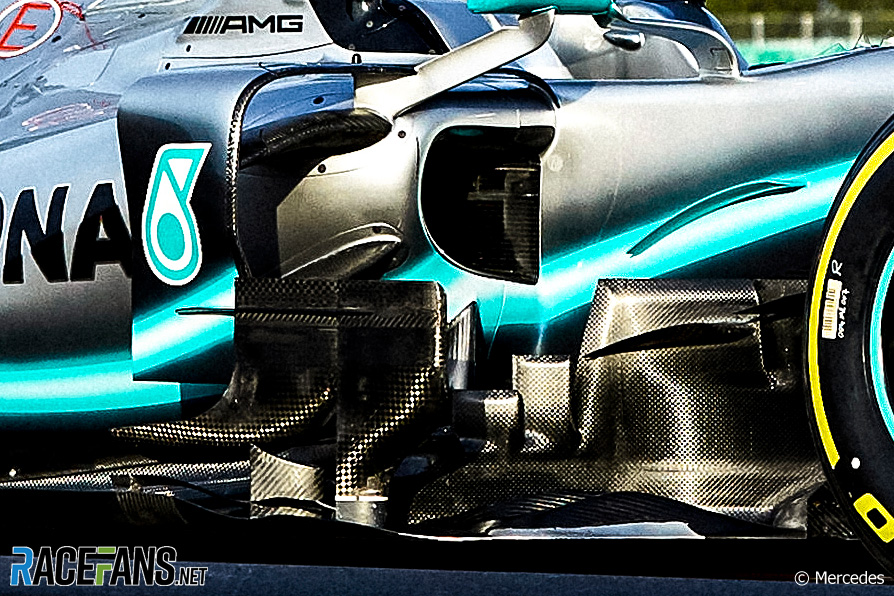
Much of the key aero concept talk since 2017 has been around sidepods, when Ferrari introduced their high-top sidepods, prompting others to follow suit. The repackaging of the sidepod inlet and crash structures form a deeper undercut below the inlet, which directs more airflow around the sidepod and over the diffuser, to create more downforce. Every 2019 car launched so far has this solution, so Mercedes’ decision to eschew this trick and go its own way is interesting.
Despite talk about different power units and different teams’ sidepods, there is a basic amount of inlet area, radiator size and sidepod volume that teams need to package. There are different ways to create the different airflow structures towards the back of the car as a result.
[smr2018test]
Any team will want to minimise the obstruction of the sidepod to the airflow in order to create more airflow over the diffuser for more downforce. You can drive airflow through an undercut and around the sidepod, or send it over the top and downwash it towards the diffuser or keep things narrow and flow it around the side.
Mercedes’ trick appears to be the latter. The sidepods are narrower at the front this year, with less of an undercut as there’s a deeper inlet. They are trying to push the airflow around a slender pod to get it towards the rear of the floor. It’s not necessarily better or worse than other ideas, if done correctly, just different.
Blisters
Further back on the sidepods there are a couple of blisters sticking out through the black painted section of bodywork. These catch the attention, but similar bumps have been on the Mercedes since 2014.
The power unit regulations have specific positions for where the engine mounts to the chassis and gearbox. With the evolution of the V6 engine, the mounts are now some way from the smaller engine within. This allows teams to package bodywork much closer to the engine itself, but the mountings cannot be repositioned, so the result are these bulges.
Rear suspension
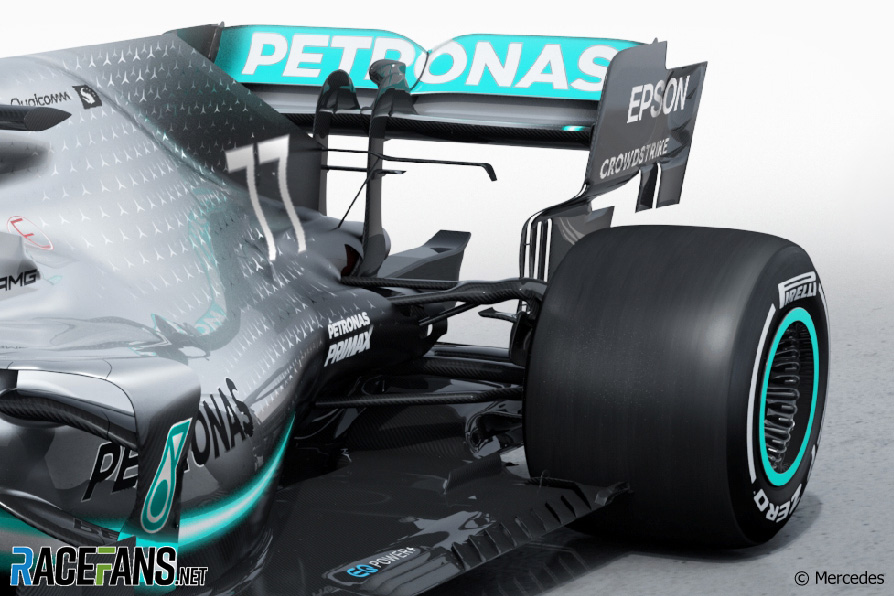
Many of Mercedes’ problems over the past few years have been tyre management and a set up that is on a knife-edge. A lot of this revolves around the rear suspension and its effect on the rear tyres, which have been struggling to keep temperatures low enough to keep them in their working window.
Last season this was often a problem until the team introduced mid-season updates which altered the rear suspension and brake ducts brought it under control. This also included the drilled and finned rear wheels whose legality became such a big talking point in the last few races.
In 2018 the rear suspension geometry was altered, partly for kinematics, but also for aerodynamics to push the rear leg of the top wishbone into the airflow to direct it through the rear wing.
This year this extreme raising of the top rear wishbone has been eased, with the inner mounting far lower on the gearbox. As a result the wishbone is angled upwards towards the wheel. This reduces the aero gain, but brings a better geometry, to get the right change in camber with the suspension’s movement.
Also note those late-2018 style drilled and ribbed rear wheels are still fitted to the car. As their legality was left unresolved last season, this may be an excuse for a flare up with rivals at the first races, or alternatively their rivals may choose to follow the heat-exchange tricks with their own rear wheel designs.
Advert | Become a RaceFans supporter and
Video: Mercedes reveals its new W10 at Silverstone
F1 technology
- Pictures: Alpine’s new front wing and more Suzuka updates
- Pictures: Red Bull bring first performance upgrade for RB20
- How teams have tweaked their cars to hit higher speeds in Jeddah
- ‘A horrible project’: Why duplicating Red Bull’s trend-setting suspension is so difficult
- Aston Martin, Mercedes, Haas and others describe extensive US GP updates




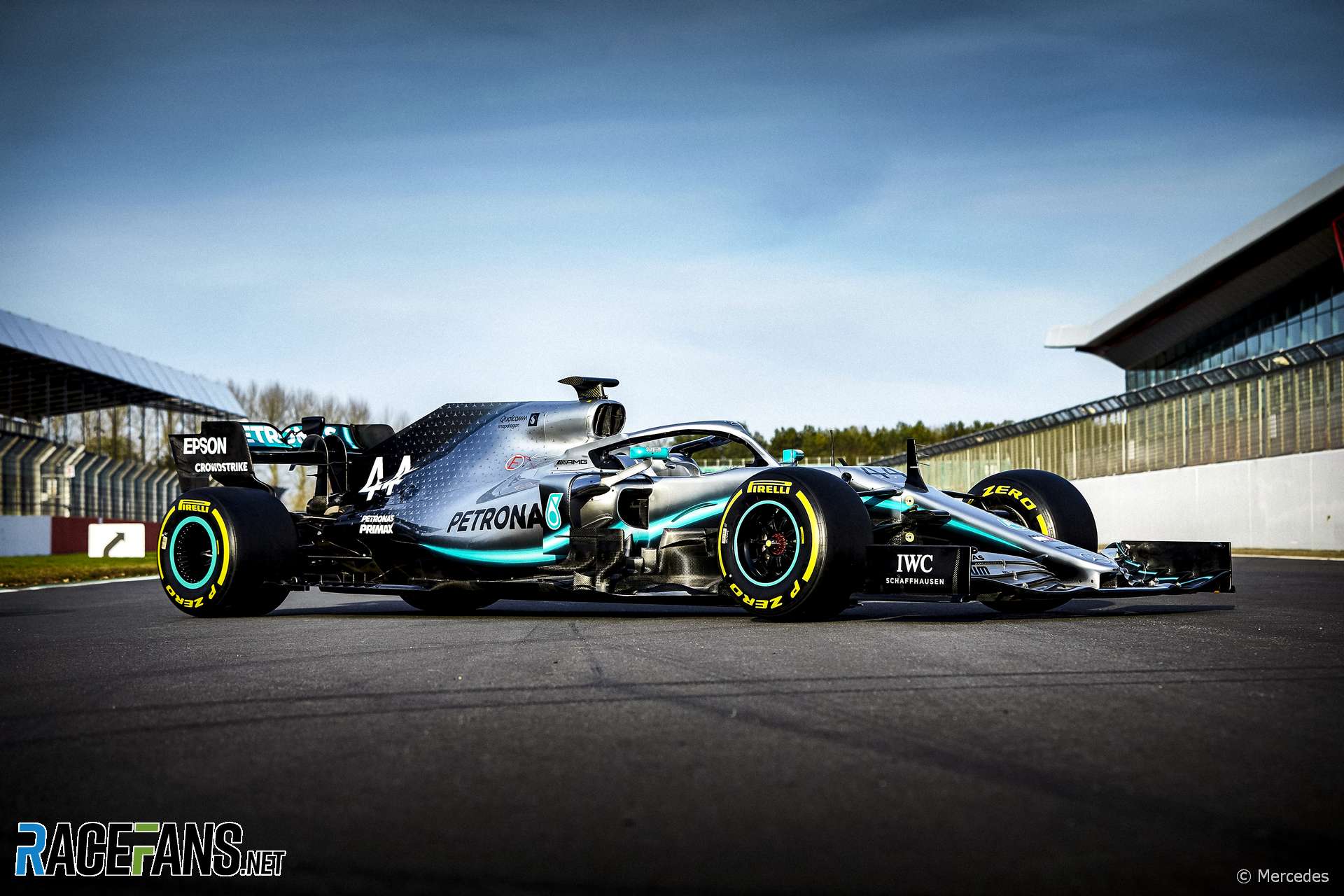
Phylyp (@phylyp)
15th February 2019, 18:01
The car’s a looker. Purely by livery it looks modernized (as opposed to the Williams which looks a step back).
jakoby
16th February 2019, 23:04
Excellent article on Mercedes aces,factory;team and all.
However it seems ,that you forgot ;to add the biggest asset of them all:The TATTOO guy that has won over 51 % of all Hybrid eras races so far and counting….
I believe it to be the biggest plus and asset Mercedes has got.
Ferrari has already found out the hard way by losing the last 2 Drivers championship.
Keep the good work racefans.net. My sizeable contribution coming shortly.
NoName (@noname)
17th February 2019, 8:34
@Jakoby Well said.
mystic one (@mysticus)
18th February 2019, 2:21
Tatoo guy has a few changes too, looks like having slim lines with those polished eye brows and much more aero shaped hair-pin lines on the head to direct air smoothly around the head… not sure the legality of the shark fin on top though, teams may question it, but the side pots are spot on!
Mach1 (@mach1)
15th February 2019, 18:42
Interesting….I would have said that the Merc was the most radical this far in a departure from their previous car. Was their car last year not emulating to a certain extent the high sidepod design of Ferrari. Maybe not as fully, but it was certainly going down that path….
This seems to be a reversion to the a more traditional sidepod design….and when compared to rest of the field, it now stands pretty much alone in philosophy…
When you also consider that they come from leading the pack for the last 6 years and only just having the edge in pure car performance terms over the course of the year….I would say this is certainly a more radical change in that context….
DaveD (@daved)
17th February 2019, 20:25
@mach1
I was wondering if they were going this route with the sidepods to emulate something Adrian Newey was doing on Redbull last year. Maybe they’ve found some newer way to get more out of a slender torso vs the undercut of everyone else.
I know I was HIGHLY worried and suspicious when I saw the Rebull boys had gone a different direction. The fact that they were competitive with a lesser engine tells me they were probably onto something.
@HoHum (@hohum)
15th February 2019, 20:27
Another example of the pointless rigidity and conformity of the F1 design rules : Fixed position engine mounts that now require “bumps” in the bodywork to house them. Why ? Perhaps an aerodynamic challenge to see which team can build a better bump. No wonder the teams with the biggest budgets are a couple of seconds a lap faster, they are the ones that can afford to pay someone to spend a couple of months refining the shape of the bumps to enhance the airflow over them as the design of wings and widgets evolve.
gDog
16th February 2019, 17:44
Fixed engine mounts would have been intended to make it easier for teams to integrate different engines and therefore encourage more engine manufacturers. However, now the teams have shrunk the packaging so tightly the engine mounts are now way further apart than they need to be.
Seems like a good idea in principle, maybe the regs just need updating to reflect the smaller size of the current engines.
DaveD (@daved)
17th February 2019, 20:28
Good points, @hohum and gDog. I’d love to see them update or do something to get away with silly bulges that serve no purpose.
Green Flag (@greenflag)
15th February 2019, 21:16
“The team have many aces: its engine power, qualifying modes, refined aerodynamics and great handling.” Not mentioned is the most important piece of equipment that no other team has. Technically it’s known as a “Hamilton”. Until other teams manage to develop their own Hamilton Mercedes will keep winning.
Shimks (@shimks)
16th February 2019, 1:17
Well, initially I was going to disagree. I was going to say that although The Hamilton (™ @greenflag 2019) is an outstanding driver – almost surely the very best on the grid at the moment – it has been seen time and time again that the chief designers have a much bigger impact than the driver on a team’s on-track fortunes. But, thinking about it, it’s a combination of the two, isn’t it. And I think Hamilton could have won the championship last year with Vettel’s car – so I guess that says it all. But, then again, I still rate El Alonso® as equal to The Hamilton, but he certainly couldn’t do the impossible with that McLaren he had. So I guess I will settle for it being a balanced act being human and machine!
DaveD (@daved)
17th February 2019, 20:32
As a HAM fan, I couldn’t agree more @shimks
I wish El Alonso (™ @shimks 2019 LOL) would have been in a car even remotely competitive so we could have seen a three or even a 4 way fight at the top assuming the Redbulls would have had a bit more engine.
I watched Alonso during the Rolex 24 a few weeks ago, and it was just fun to watch him school the field while he was doing his stints. Too bad the weather was so bad that it robbed us of drama at the finish.
Shimks (@shimks)
18th February 2019, 6:26
Yes, @daved, it really is a crying shame the machinery Alonso got to use in the second half of his F1 career. If Ferrari had managed to get it right while he was there, he would have been glorious. His McLaren stint is best completely forgotten, I guess, although I still smile when I hear “GP2!” echoing in my head now and then; and when that happens, I picture him in that deck chair.
David BR (@david-br)
16th February 2019, 12:29
More or less agree, though a more tactically astute Verstappen would be a big challenge. The other thing is that, yet again, Mercedes don’t really seem to design their car around the skills of their top driver, he’s expected to adapt to it. Which he does fine. But still. Their focus seems to be on straight out speed rather than racing potential, corner handling etc. which Ferrari and Red Bull seem to offer more. One of the reasons why I’d like to see him in one of those cars before he retires from F1.
jacoby
16th February 2019, 23:08
Excellent argument green flag.
I could not agree more and wrote my comment without reading yours.
Spot on.
NoName (@noname)
17th February 2019, 8:59
@greenflag Well said, as if the car drives itself.
Wayne
15th February 2019, 21:32
Very informative thanks for technical breakdown. Have to also agree with green flag. Also the car looks awsome.mclaren reli should take a page or full encyclopedia out of mercedese….
Johns
15th February 2019, 23:12
Stupid FIA. If they want to get rid of the outwash wings and make the cars better when overtaking, just make the wing elements extend all the way to the nose cone. By having the gap from the nose cone to the wing elements, a large vortex is set up that everyone exploits. Get rid of this vortex generator and the outwash problem goes away me thinks. Also forces everyone to rethink the floor design, etc.
Pete
16th February 2019, 0:26
No mention of the rear wing changes?
The cars are a legacy of decades of FIA solid rules, sadly the ’17 extra freedom didn’t resolve that.
Different approaches are fine and if the low(er) sidepods work for the Merc’ then why not. There is more than one way to skin a cat.
Interesting to see the rear suspension has gone to a more tyre friendly setup, must bring more gains than the aero it afforded them before?
I really hope it’s still a contender, but I also hope that Ferrari turn up with a fast car too. Would be nice to have another year (or at least first half) of tight battles at the front
Dom (@3dom)
25th February 2019, 13:52
I know it’s late, but I really have to say that it’s great to have your analysis on here @scarbs